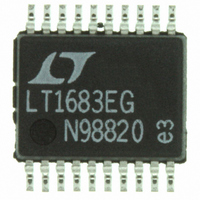LTC1562CG-2 Linear Technology, LTC1562CG-2 Datasheet - Page 10

LTC1562CG-2
Manufacturer Part Number
LTC1562CG-2
Description
IC FILTER UNIVRSL RC QUAD 20SSOP
Manufacturer
Linear Technology
Datasheet
1.LTC1562CG-2PBF.pdf
(16 pages)
Specifications of LTC1562CG-2
Filter Type
Universal, Continuous-Time
Frequency - Cutoff Or Center
300kHz
Number Of Filters
4
Max-order
8th
Voltage - Supply
4.75 V ~ 10.5 V, ±4.75 V ~ 5.25 V
Mounting Type
Surface Mount
Package / Case
20-SSOP
Lead Free Status / RoHS Status
Contains lead / RoHS non-compliant
Available stocks
Company
Part Number
Manufacturer
Quantity
Price
Part Number:
LTC1562CG-2
Manufacturer:
LINEAR/凌特
Quantity:
20 000
Company:
Part Number:
LTC1562CG-2#PBF
Manufacturer:
Linear Technology
Quantity:
135
Company:
Part Number:
LTC1562CG-2#PBF
Manufacturer:
LTC
Quantity:
200
Part Number:
LTC1562CG-2#PBF
Manufacturer:
LT凌特厂
Quantity:
20 000
Company:
Part Number:
LTC1562CG-2#TRPBF
Manufacturer:
LINEAR
Quantity:
3 145
Part Number:
LTC1562CG-2#TRPBF
Manufacturer:
LT凌特厂
Quantity:
20 000
LTC1562-2
APPLICATIONS
Because 2nd order sections with Q
peaks near f
thumb:
The following situations are convenient because the
relative swing issue does not arise. The unused output’s
swing is naturally the smaller of the two in these cases:
The LTC1562, a lower frequency variant of the LTC1562 -2,
has a design center f
LTC1562-2. The rules summarized above apply to the
LTC1562 but with 100kHz replacing the 200kHz limits.
Thus, an LTC1562 highpass filter section with f
100kHz automatically satisfies the desirable condition of the
unused output carrying the smaller signal swing.
Low Level or Wide Range Input Signals
The LTC1562-2 contains a built-in capability for low noise
amplification of low level signals. The Z
each 2nd order section controls the block’s gain. When set
for unity passband gain, a 2nd order section can deliver an
output signal 99dB above the noise level. If low level inputs
10
f
f
Lowpass response (resistor input, V2 output, Figure 5)
with f
Bandpass response (capacitor input, V2 output, Figure
6b) with f
Bandpass response (resistor input, V1 output, Figure
6a) with f
Highpass response (capacitor input, V1 output, Figure
7) with f
O
O
V
< 200kHz
> 200kHz
IN
O
7.87k
R
Figure 8. 200kHz, Q = 0.7 Lowpass Circuit
for Distortion vs Loading Test
< 200kHz
IN
O
O
O
O
> 200kHz
, the gain ratio above implies some rules of
INV
> 200kHz
< 200kHz
1/4 LTC1562-2
5.49k
2nd ORDER
R
Q
V2 tends to have the larger swing
V1 tends to have the larger swing.
V1
O
U
of 100kHz compared to 200kHz in the
V2
INFORMATION
R2
7.87k
U
C
30pF
L
W
R
(EXTERNAL
LOAD RESISTANCE)
1 have response
1562-2 F08
L
IN
V
OUT
impedance in
U
O
above
require further dynamic range, reducing the value of Z
boosts the signal gain while reducing the input referred
noise. This feature can increase the SNR for low level
signals. Varying or switching Z
effect automatic gain control (AGC). From a system view-
point, this technique boosts the ratio of maximum signal
to minimum noise, for a typical 2nd order lowpass re-
sponse (Q = 1, f
Input Voltages Beyond the Power Supplies
Properly used, the LTC1562-2 can accommodate input
voltage excursions well beyond its supply voltage. This
requires care in design but can be useful, for example,
when large out-of-band interference is to be removed from
a smaller desired signal. The flexibility for different input
voltages arises because the INV inputs are at virtual
ground potential, like the inverting input of an op amp with
negative feedback. The LTC1562-2 fundamentally responds
to input current and the external voltage V
across the external impedance Z
To accept beyond-the-supply input voltages, it is impor-
tant to keep the LTC1562-2 powered on, not in shutdown
mode, and to avoid saturating the V1 or V2 output of the
2nd order section that receives the input. If any of these
conditions is violated, the INV input will depart from a
virtual ground, leading to an overload condition whose
recovery timing depends on circuit details. In the event
that this overload drives the INV input beyond the supply
voltages, the LTC1562-2 could be damaged.
The most subtle part of preventing overload is to consider
the possible input signals or spectra and take care that
none of them can drive either V1 or V2 to the supply limits.
Note that neither output can be allowed to saturate, even
if it is not used as the signal output. If necessary the
passband gain can be reduced (by increasing the imped-
ance of Z
The final issue to be addressed with beyond-the-supply
inputs is current and voltage limits. Current entering the
virtual ground INV input flows eventually through the
output circuitry that drives V1 and V2. The input current
magnitude ( V
design to less than 1mA for good distortion performance.
On the other hand, the input voltage V
IN
in Figure 3) to reduce output swings.
IN
O
= 200kHz), to 114dB.
/ Z
IN
in Figure 3) should be limited by
IN
is also an efficient way to
IN
in Figure 3.
IN
appears across the
IN
appears only
15622fa
IN














